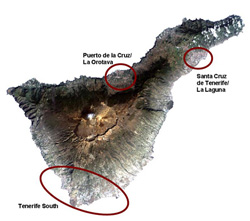Objectives:
The Canary island of Tenerife is a popular destination for Central Europeans since decades. But by this mass tourism the land use on Tenerife changed widely. The changes arose however not everywhere and not equally strong, there are regions with intensified land use change and parts of the island, where hardly no change occured.
Didactical comment:
- The worksheet assists the students in analysing satellite images and land use classifications of Tenerife of the years 1978 and 2002. These images and classifications are made available on the SEOS module. On the worksheet, regions should be marked, in which changes of the land use are most clearly visible.
- In a second step, the students should think of possible causes, especially about mass tourism and should include their everyday life and past vacation experiences in their thoughts. They should take over the role of a tourist and think of tourist demands and what has to be done for it. In a next step, consequences which result from this demands can be discussed. Subsequently, these consequences could be discussed for the island of Tenerife.

Source: Landsat
Solution of Worksheet 'Land Use Change on Tenerife'
1. Mark on the above image the areas where land use change is most visible when comparing the classifications of 1978 and 2002 (see: landuse-c04-p02.html).
The students should compare here two land use classifications of Tenerife. On the worksheet something similar to this should be seen:
2. What could be the reasons for these changes? Follow especially the progress of development:
Main cause of the rapid changes of land use is tourism. With this, the following is connected: the expansion of cities and/or structural changes (hotel, infrastructure) connected with tourism, growth of urban regions, abandonment of unprofitable agricultural occupations.
The main changes can be found in the three tourist centers of the island and at the coasts. In the area of the Teide volcano, hardly any change occured due to the relief, soil and vegetation conditions, the accessibility and the missing interest of the visitors.